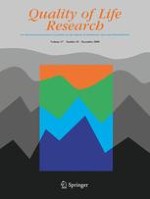01-12-2008
Lower visual acuity predicts worse utility values among patients with type 2 diabetes
Gepubliceerd in: Quality of Life Research | Uitgave 10/2008
Log in om toegang te krijgenAbstract
Objective
We estimated the quality of life impact of vision loss in a community-based population with diabetes.
Design and methods
We randomly surveyed 4,000 members of a large health maintenance organization with type 2 diabetes to assess quality of life using the EQ-5D instrument. Visual acuity was obtained by automated text processing of clinical notes recorded during the two years preceding subjects’ surveys. Natural language processing was used to collect data from electronic medical records and to read clinical notes to determine the stage of retinopathy. Linear regression was used to model quality of life scores.
Results
Of the 4,000 surveys sent, approximately 55% of patients responded. Patients with ≥20/20 acuity reported the highest mean utility (mean = 0.82), which declined as the visual angle doubled to 20/40 (mean = 0.75), and then doubled again to ≤20/80 (mean = 0.71). Perfect utility (1.0) was reported by 28% of the sample. Only 7% of patients suffered visual impairment (≤20/40), and lower levels of visual acuity rarely occurred. Compared with patients with ≥20/20 acuity, the first doubling of the visual angle (20/40) lowered utility by three points (95% confidence interval [CI], −0.05 to −0.01), and the second doubling of the visual angle (≤20/80) lowered utility by six points (95%CI, −0.10 to −0.02).
Conclusions
This study aimed to estimate disutility associated with visual loss in patients with diabetes using a community-based sample and controlled for many characteristics associated with quality of life. We found a smaller utility decrement compared to other studies, suggesting that visual acuity’s impact on the quality of life for patients with diabetes in the community setting differs from more selected populations.
